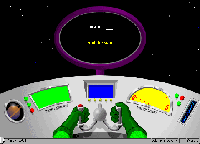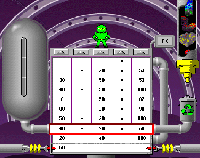





|
Sample Dialogue from
Math Blaster 1: In Search of Spot
 Image © Knowledge Adventure. Used with permission.
Image © Knowledge Adventure. Used with permission.
Puzzle: The Trash Zapper
The first activity encountered in Math Blaster is much like a traditional math worksheet put onto the computer. You can choose the content (such as multiplication or subtraction) and the level of difficulty (there are 6). Players type in answers to number problems that appear on the windshield of the spacecraft, and then zap the trash floating outside the spacecraft.
G&P, girls aged 11 and 12, chose to play Addition at Level 4, which means they are answering problems such as "50 + 30 = _ _." As they begin play, P. comments that she has played this game before ("I know this one.") It is unclear whether G. has ever played it before, but she has at least seen a short introduction to the game, which included the story and a quick sampling of each of the activity areas. This section of dialogue represents about two and a half minutes of play. (*) represents a computer noise signifying the correct answer.
G. and P. are worried about the speed at which they are working, although the game does not reward quicker answers (or trash-shooting). In fact, there is no time pressure present in this activity. However, the video game feel of this area (and possibly the similarity of the screen to a flash-card-like activity) tends to inspire a focus on speed in the children we have observed playing it.
Dialogue
--P: I know this one. I know this one. ... [pause while the game loads]
--G: 50 times... 5, 6, 7, 8.
--P: 80. You have to write it fast because, (*)
--P: Fast, fast! 90.
The emphasis on speed leaves little time or inclination to talk or reason about the math. Other than the above section, where G. seems to count up to solve the problem, there is no mathematical talk or reasoning other than the calling out of answers. Although they are saying a lot of numbers, an important emphasis in such number work is understanding the meaning of equations, and how you and others solve such computation problems. In this episode you never hear the questions they are answering, let alone an explanation of a solution strategy.
--G: 90. (*) 60. (*) 40. (*)
--P: 80. (*)
--P. leans back.
--G: Take! Just press the button.
--P. shoots the trash.
--P: (leans in again to type, gives an inaudible answer). (*)
--Both: 60. (*)
--G: 100. (*) 40. (*) 30. (*) Gotta get them all.
--P. shoots the trash.
The highest levels of engagement seem to be with shooting the trash at the end of the round. A common goal players set for themselves is getting every single piece.
--G: Yes! (P. shot all 5 pieces of trash.)
--Both: 70. (*)
--Both: 20. (*)
--P: 50. (*) (*) (*)
--G: Get the fish [a piece of trash]!
--P. shoots the trash.

Puzzle: The Number Recycler
The player directs the alien across 3 columns of numbers, in an effort to make the last row of numbers into a mathematically-correct equation. By jumping on the top of a column of numbers the alien shuffles all the numbers in the column down one row. The goal is to do this in as efficient a way as possible, as more than one jump on a column results in the loss of numbers. When all the trash collected in The Trash Zapper has been transformed into fuel, the player has won this activity.
G&P are playing Addition at Level 5. As they begin play, P. comments that she has played this particular activity before ("I remember this."). It is unclear whether G. has ever played it before, but she has at least seen a short introduction to the game, which included the story and a quick sampling of each of the activity areas. This section of dialogue represents 6:33. (*) represents a computer noise signifying the correct answer.
Compared to the dialogue of the same girls playing the Trash Zapper, it is clear these children are talking and interacting more, with each other and with the mathematics. They are thinking and reasoning aloud, doing more than just calling out numbers or answers, testing different possibilities and justifying them, and are interested in controlling the mouse and/or the decisions.
Dialogue:
--G: 30 plus 50 ... zero. ... Can I do the next one?
(P: Wait. G. takes the mouse.) 70 plus 50. 70 plus 50 is equal to... 70 plus 50 is equal to...
--P: 12. (Asks for paper and pencil, writes.) 12. It's 12. One hundred and twenty.
--G: I think we should change these, this number.
--P: Yeah. ... What if you did (P. with mouse again.) 70 plus that, 20 makes, or 6 equals fift...
--G: Uh 30 plus... no. 20, 60 plus 20.
--P. asks something, G. answers "80, 80." (P: 80?)
--One line of numbers gets burned. (*)
--G: Now more, 50 plus 30 is 80. (P: 80?) Yeah. That's (*) 40 plus 20, ok. (*) You need, that's ok. (*) You need to change this.
--P: I know. (*)
--G: 50 plus 50, change this.
--P: It's not 90 it's 100.
--G: 50 plus 40.
--P: Wait 50 plus 40. (G: 40) Yeah.
--G: It comes to 90.
--P: Have to change both of these numbers.
--G: Yeah you have to change, 50 plus 40, it's 90. Change more.
--P: How about 50 plus 20?
--G: No it doesn't make it.
--One line burns. (*)
It is interesting that such a slight change in the mathematics (from an activity that is straight drill and practice to one that involves more thinking and reasoning rather than just recall) could effect such a noticeable change in children's interactions with this game.

Back to the top of the page
|



